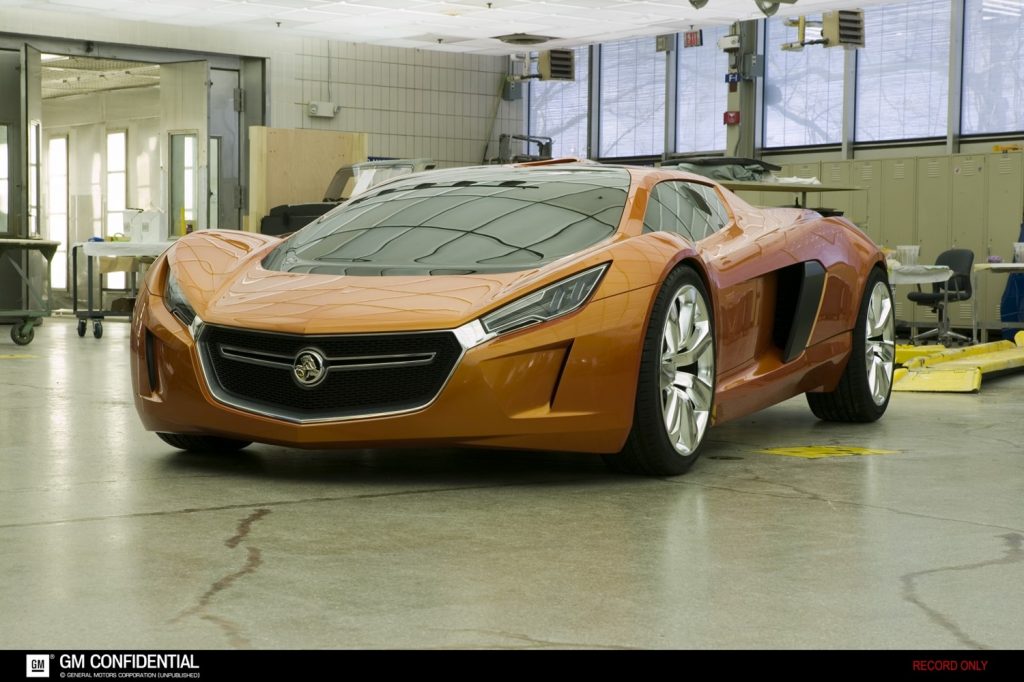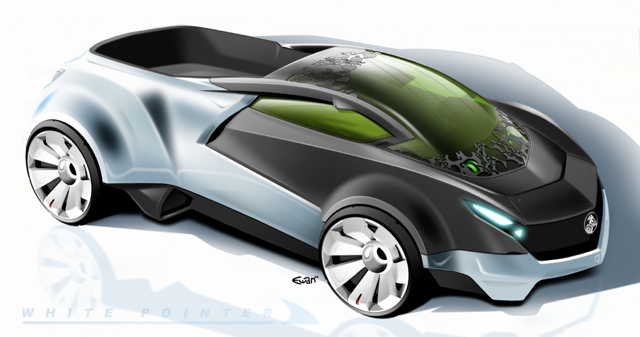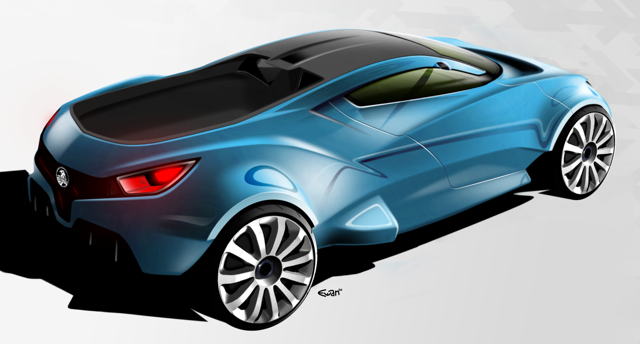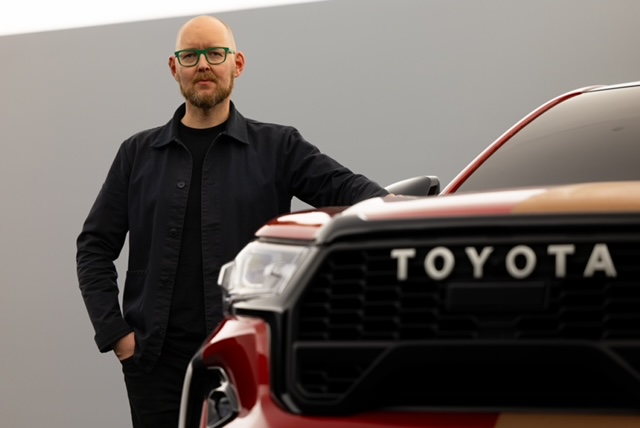by Peter Robinson – – –
(This story first appeared in Wheels, June 2025)
This was a scoop so fantastic that few readers believed it. Did Holden really conjure an electric-powered supercar, a rival for the Bugatti Veyron, that also just happened to be a ute?
All true. And here’s the proof.
Until now, the Wheels, September 2016 cover story scoop, revealed by Toby Hagon after sighting a grainy image of the car on a GM Facebook page, has only been seen in digitally enhanced copies created from the video.
Now, thanks to research by the archivists within GM’s American Heritage Centre, we can confirm the existence of Holden’s outrageous skunk works Super Ute program by laying bare photographs of the models developed during the creative process. The scale models – first one-third, then Holden’s full-size clay, plus another handmade, full-size hard model built in Detroit – confirm that the project was, for a time in 2007/2008, at least semi-serious. They also verify the remarkable accuracy of Wheels’ images.

The story of the Super Ute goes back to 2006, two years before General Motors was to celebrate its centenary. GM asked each of its global brands, not least Holden, to create a show or concept car to be displayed at an international centenary event planned for Florida in 2008. Tony Stolfo, then Holden’s design boss, asked his team for ideas – wild or not – for Holden’s contribution. The gates were open, and the designers took every opportunity to express their fantasies.
Ewan Kingsbury, then a young Holden designer, wondered if it was possible to combine the idea of an EV supercar that merged sleekness with a level of practicality that invoked Australia’s much-loved ute body style. The idea wasn’t original; Kingsbury remembered Isuzu’s 1991 Como F1 concept. Styled by Simon Cox, who later designed several memorable Cadillac concept cars (Cien, Converj), the Como was powered by a new Isuzu 3.5-litre V12 (intended for Lotus’s F1 car), mounted amidships. More importantly, in Kingsbury’s mind, Como also featured an elongated and covered tray area behind the engine to essentially create a ute.
Ewan, aware that GM’s Chevrolet division was working on a revolutionary plug-in hybrid and extended range EV vehicle, that became the Chevrolet Volt, pondered the possibility of using this powertrain for his supercar. The Volt, first shown as a concept in 2008, took three years to reach production in 2011. Kingsbury wanted to combine two Volt powertrains, with one electric motor at the front and one at the rear, in his supercar. (The Volt was briefly sold in Australia as a Holden from December 2012.)

His radical supercar sketches, proudly wearing a bold Holden lion badge, attracted the attention of Peter Hughes, his manager. Quickly, two other Holden designers – Andrew Harrison and Warrack Leach – were sketching the same concept. The idea was sold up the design chain to Stolfo. Julian Broadbent, director of Holden’s advanced portfolio planning, became involved on the technical side. Richard Ferlazzo, Holden’s last design boss, remembers there were discussions around the powertrain. If not an EV, why not a V12? This stillborn engine layout, cultivated by Michael Simcoe, for an ultra-long wheelbase limousine Holden (or even a Cadillac) and created by the amalgamation of two Holden Alloytech V6s on a common crankshaft to create a possible 7.2-litre 12-cylinder engine, was briefly considered during the VE Commodore’s development. At Holden in the 2000s (at least until the GFC), nothing was too ambitious.
“In 2007, we were thinking about the future of Holden,” says Kingsbury, “beyond the VE, beyond a bogan burner, we wanted something with a sporting cache.”
At the time, despite losses in the years immediately preceding the Global Financial Crisis, Holden under new CEO Mark Reuss (now GM’s President), was optimistic, its design and engineering groups openly searching for new ideas, especially in exploring alternative propulsion solutions. Design, having for decades been positioned within engineering, was now included in design boss Ed Welburn’s global organisation and he increasingly encouraged pioneer advanced design solutions. Post the GFC, Holden design would go on to create a long list of proposals for GM’s overseas brands, including a few that were made public like the Opel Excite GT concept, and Buick Avista and Avenir show cars.
“We wanted something that was super low, a sports car, yet not just another supercar… what about a super ute?” says Ferlazzo today. “Almost an (automotive) pun, something that was iconically Australian, yet didn’t fit our portfolio.”
Eventually, after much debate, it was decided to combine the three different designer sketches in creating the model to take to the scale model stage: Kingsbury’s cab-forward nose, Harrison’s midsection and Leach’s stretched rear end.

The result, with its tiny front and rear overhangs and radical, rear-hinged lift-up scissor doors, was pure and extreme supercar. Except that its profile proportions with its extended tail mirrored a Commodore ute. Because it was an EV, few intakes, that add enormously to drag, were required, meaning the coefficient of drag could be kept remarkably low, though as far as we can gather no wind tunnel tests were performed. On looks alone, you’d expect to see a longitudinally mid-mounted monster V12 housed in the extended rear. Instead, under the small, bath-like tray area, would be a bank of lithium-ion batteries. The idea was to have the Volt’s modest 1.4-litre four-cylinder engine behind the two-seat cabin and ahead of the batteries. Wombat would be recharged by this onboard power source, just like the Volt.
Hagon believes the decision to use the Volt generator and electrical architecture was “a tactical move to prove to Detroit that Holden could work within the carmaker’s globalisation framework.”
It was Hughes and Kingsbury who came up with the Wombat label for their Ferrari-beating concept.
“It was a joke”, says Kingsbury, “but people started to call it Wombat and that’s what it became. It wasn’t really a ute, the tray was so shallow.”
Harrison and Broadbent took over the project, though Ferlazzo says it was never an official program, and a silver one-third scale model was built in Holden’s Port Melbourne studios before being photographed in design’s famous courtyard. When the green light was given to develop a full-size rolling clay model, Kingsbury, remembering the wild 1969 Holden Hurricane concept, decided Wombat should resurrect the Hurricane’s orange exterior colour.
Built with technical support from Ken Rutherford, a former F1 engineer (Benetton and Arrows) who now runs M-Sport Design in Melbourne, the full-size model wore 22inch wheels wearing 365mm wide rear rubber (the fronts were smaller), was just 106cm high, over two metres wide and just under five metres in length. Engineering simulations revealed that Wombat would be capable of hitting 100km/h in just 2.3 seconds, two-tenths faster than the Bugatti Veyron, then the world’s fastest supercar, and only 0.15 behind Ferrari’s new F80. Top speed? It’s not known if GM did any simulations, but conservatively, we’d say at least 300km/h.
The orange full-size clay was trucked to Lang Lang, Holden’s proving ground, to be photographed and reviewed by senior management on the skid pan. The decision was taken to cautiously proceed with the project. However, a seating buck was never built, so the doors were not real and could not be opened. The designers sketched interiors, but these came to nothing.
Bob Lutz, then GM’s global product boss and a firm supporter of Holden’s role as GM’s home of rear wheel drive development, saw the full-size clay in 2008. Predictably, it was Lutz who advocated for a production version that he believed could also be badged Cadillac, Opel, Chevrolet as well as, of course, Holden. Welburn also monitored development from Detroit and ensured Holden’s full-size clay was digitally scanned for any future CAD-CAM developments.
In late 2008 Lutz, seeing Wombat as an ideal hero car to sit beside the Volt in GM’s global showrooms, approved for the digital data to be transferred to Detroit to be made into a hard model. (It’s believed that Holden’s full-size clay was recycled in Australia, though it may have been one of the models lost in floods that later devastated the basement of Holden’s Technical Centre). Machined out of Ureol, a type of board material of polyurethane and epoxy resin, known for its use in modelling and tool making, this model, built to motor show standards, and is believed to have been shown to senior GM brass at a leadership summit in 2009. Respecting Holden’s Hurricane heritage, the American Wombat was also finished in gold.
Hagon, quoted one Holden insider saying, “We’d sourced batteries, electric motors…. all the components needed to build the vehicle. We did a lot of the architectural validation and simulation work.”
But it was not to be. After decades that saw GM’s market share inexorably decline from a peak of over 50 percent during the 1960s to just over 20 percent in 2008, and losses grow, GM filed for bankruptcy protection on June 12, 2009. High fixed costs and debt, combined with falling sales, forced GM to seek a government bailout. A new company was formed, brands – Pontiac, Saab, Saturn and Hummer – were abolished, many global production programs were eliminated. Narcissistic projects like Wombat, unable to quickly bring in serious money, were terminated.
Realistically, at least in my view, the concept of a supercar truck was not just outrageous, but ridiculous. There’s a reason why Isuzu didn’t proceed with Como and it’s not just because the 477kW (640bhp at 12,500rpm) V12 was too expensive to build at a time when Japan’s economy was in free fall. Nobody, not even if it’s badged Ferrari, is going to be interested in a supercar ute. Isuzu or Holden, the idea is contradictory and just plain silly.
Yet Wombat proves, again, the enormity of what Australia lost with the end of local manufacturing and Holden’s so productive and enormously creative local design studio and advanced engineering sector. In part, the revolutionary electric supercar, intended to showcase Holden’s design and engineering talents within GM’s world, achieved its aim, but arrived just as General Motors was declared bankrupt. In such circumstances, Wombat had no chance.
Does the full-size model survive in GM’s huge heritage fleet? Christo Datini, who heads the GM’s archive told me, “I checked the inventory of vehicles/properties retained then placed in Australian museums by GMA. The Wombat does not appear on it”.
What happened to the young designers responsible for Wombat? Kingsbury is now creative design manager at Toyota Australia; Warrack Leach moved from Holden to become a design manager at Ford Australia in 2019; while Andrew Harrison is exterior design manager at Bentley having moved to the UK in 2013. To confirm his enthusiast credentials, Kingsbury’s daily drive is a Lexus NX, but he keeps a Series 2 Lotus Elise for track days.


